Last week, I mentioned several utilities that are helpful but time constraints caused links to the various websites to be omitted. The links are now present and you'll find last week's program here.
Ready to Make a Slide Show? It's Easy.
Following a birthday party, an anniversary dinner, a wedding, or a vacation, you might want to share some of your images with others. In the very old days, that meant dragging out a screen and a slide projector. Or you could have prints made and send them to people. More recently, we've been able to e-mail photos or post them on Facebook or Flickr or any other of the social media. But some people want to do more. They want a presentation with music. Maybe some narration. Images that fade from one to the next. If that describes you, take a look at Magix Photostory Easy.
Although Magix calls the application Photostory Easy, it can also handle video clips so it's possible to combine still and motion images in a single presentation. Magix is a well known name in Europe (it's headquartered in Germany) but somewhat less known in the United States.
To test Photostory Easy, I started with nearly 100 images of one of the cats, Tangerine, who died in 2010. After importing all of the images, I looked through them and eliminated ones that seemed not to fit, duplicates, and ones that had technical flaws.
Although the on-screen time can be set for each individual image, I started with 5 seconds for all of the images and modified the times for a few images later. The time display might be a bit confusing for amateur users: 5 seconds, for example, is displayed as 00:04:29. The NTSC (National Television System Committee) standard calls for 29.97 frames per second so 4:29 is really 5:00 (more or less). The NTSC system (which some video engineers say really means "never twice the same color") is the analog television system used in North America, South America (except for Brazil, Argentina, Uruguay, and French Guiana), Myanmar, South Korea, Taiwan, Japan, the Philippines, and some Pacific island nations.
One of the new features in this version is called "soft tracking". You may know this better as the "Ken Burns Effect". Ken Burns didn't invent the effect, but he has used it so frequently and so well in creating documentaries that rely on the use of still images that his name has become associated with it. The effect is created by slowly zooming in or out, panning vertically or horizontally, using various cross-fade transitions between frames. The result is a more lively and animated production.
Photostory Easy allows the addition of a music track and a separate narration track. The narration track automatically takes precedence over the music track so that the slide show creator doesn't have to make each adjustment manually. I was disappointed by not being able to create a cross-fade between music tracks and the automatic fade out at the end is abrupt to the point of being harsh. An alternative would be to create a separate sound track using an audio program and then using the recorded sound track on the Photostory Easy music track.
There's also an option to allow Magix to create the sound track for you. According to Magix, you select the appropriate style and a wizard will take care of the rest for you. "All songs are professionally composed and transform any slide show into an audio and visual work of art."
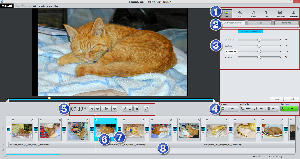 The program's interface has been updated to be easier for beginners to navigate. Be sure to click the image at the right for a view that's large enough to see the numbered items:
The program's interface has been updated to be easier for beginners to navigate. Be sure to click the image at the right for a view that's large enough to see the numbered items:
- Here's where you can choose whether to modify individual images (Set and View), work with your audio files or record narration (Audio), add titles (Text), select transitions, or add decorations to images.
- Once you've selected a tab in step 1, you'll have a selection of related activities here.
- Because I've selected Brightness & Contrast in 2, my options here include methods to change the appearance of the image.
- Select Title View or Image View to switch between the video track and thumbnails of all the images. Insert new object with the Photos, Audio, and Movie buttons. Output the final presentation to a video file with Finish.
- This section is primarily the playback controls so that you can preview the presentation.
- I've selected an individual image and can right-click to set the duration or make certain other changes.
- Click the icons between images to change the transition effect.
- The audio tracks are at the bottom.
Plays Well with Others
Photostory Easy can import media from all the usual suspects: SD cards, USB flash drives, internal or external hard drives, and digital cameras. Once you have the images in the application, you can modify exposure, color, contrast, color saturation, and gamma. There's an option that allows Photostory to correct all images automatically. I found that this works surprisingly well and, after applying it to all of the photos in my test set, only a few needed further manual tweaking. I didn't need to use it, but Photostory Easy also includes red-eye correction.
In my little test presentation, I set cross-fade transitions between each pair of images. Transitions are like spice: If you use too much, you'll spoil the dish. Basic cuts and cross-fades are almost always the best choice even though Photostory Easy includes other transition effects. Use them with care.
You can, of course, create title slides or add text to any slide. As with transitions, this is a feature that should be used with care. For my test, I created only one image with a text overlay—the first image. Text placement isn't entirely free-form; instead, you'll use the arrow keys to nudge text into place. The movements are in relatively large increments but still I found the placing the text where I wanted it wasn't difficult. Allowing the user to sample a color from the image to use in the text would be helpful.
Photostory Easy includes a variety of 150 or so sound effects and what Magix calls "decorations" that can be placed on top of images (and some of these "decorations" are animated). You may notice that I didn't use any of these.
Magix says that Photostory Easy can be used to combine individual pictures into horizontal or vertical panoramas. I didn't have at hand a series of images suitable for this but the application is said to include automatic focal length detection and to correct "lens distortion and perspectives."
Creating a file for a computer, CD, or DVD is easy. Creating a file that you can send to others or use on a website turned out not to be so easy. I tried to upload the Tangerine video from Photostory 3 times and each time Flickr received only the first half of the video even though Photostory reported a successful upload. Then I tried uploading a previously exported version manually. Apparently Flickr (a Yahoo operation) has a limit of 1 minutes and 30 seconds. There is no message indicating a failure. This is not a Photostory problem but it's annoying nonetheless. Next I tried an upload to Vimeo but Vimeo didn't like the file's compression mode (or, given that it was a WMV file, the lack of compression.) So then I tried using the Magix online option. It wanted to sell me a codec for H.264 but I opted out of that for now and tried to log in using my existing account. The login failed. Because I told Photostory to remember my password, it always tries to log me in and always fails. There is no apparent method to change the password. This is Photostory's error and it's annoying. Now I have a video that I can't share with anyone.
To create an H.264 video, I need the extra-cost codec. Granted, it's only $5, but having to acquire it separately is still an annoyance. At least the activation process is quick and took less than a minute. Then I was able to create a new file but Vimeo rejected it—and no wonder! The file that was 68MB as an uncompressed WMV file is now 336MB(!!!) as an MP4. Gah! For a process that's supposed to be easy, this isn't working out so well.
Then I tried exporting as an Android tablet video (high resolution). At the end of the process, Photostory offered me an option to choose the location for the file, which overwrote (without warning) the MP4 file I had created previously. Now the MP4 file is "only" 193MB and (astonishingly) Vimeo seems to be willing to accept it.
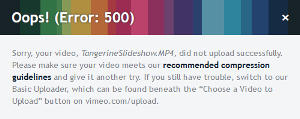 There were entirely too many of these messages as I tried to upload videos using the various options provided by the application. Eventually, though, I was successful.
There were entirely too many of these messages as I tried to upload videos using the various options provided by the application. Eventually, though, I was successful.
View the resulting video on Vimeo
The Installation Is Less than Straightforward
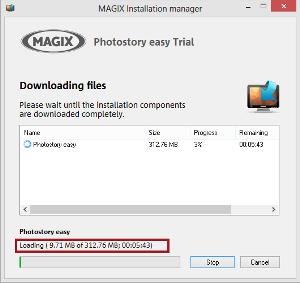 Downloading the "installation" file results in only a stub file that calls the actual installer that's on the Magix website. I don't like this process and much prefer to download the entire application and save it to a directory on the local machine before starting the installation.
Downloading the "installation" file results in only a stub file that calls the actual installer that's on the Magix website. I don't like this process and much prefer to download the entire application and save it to a directory on the local machine before starting the installation.
My Internet connection is sufficiently reliable that I can count on the download to finish but this is not the case for all people.
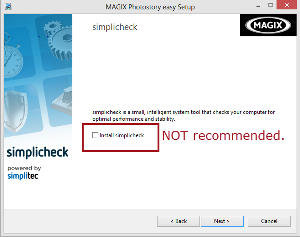 The installer also offers an option to install SimpliCheck. I wouldn't.
The installer also offers an option to install SimpliCheck. I wouldn't.
It's not a bad application but most people don't need it. Let's say you have a sore arm and you visit your doctor. The doctor examines your arm and makes some suggestions. Then, before the doctor can finish, another doctor walks in and starts making additional recommendations.
Assuming that you already have protective software, you don't need additional recommendations.
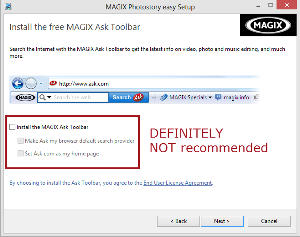 My policy is never to install a tool bar that I didn't explicitly ask for.
My policy is never to install a tool bar that I didn't explicitly ask for.
Some people like ask.com. Some people hate ask.com. I find the site useful occasionally but I don't want anything to default to ask.com.
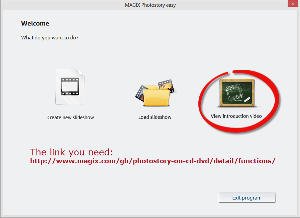 When you start the application, you 'll be offered an introductory video.
When you start the application, you 'll be offered an introductory video.
This is a good idea, but there's a problem. The video isn't in English. To view the video in English, you'll need the English language link.
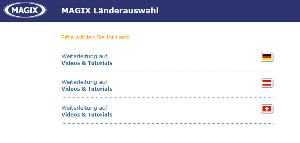 If you select the link from the application, the videos will not be in English.
If you select the link from the application, the videos will not be in English.

 Magix Photostory Easy really is, but watch out for a few gotchas.
Magix Photostory Easy really is, but watch out for a few gotchas.
I like the way Photostory Easy works and it's a good, solid application that easily rates 4 cats. I'd be happy to increase that rating to 5 cats if the installation didn't install unwanted features by default and if the export process worked a bit better.
For more information, visit the Magix Photostory website.
Correcting an Old Error
In 2005, apparently feeling a bit of nostalgia, I wrote an article about old computer hardware. In that article, I mistakenly described the world's first mouse, the one created at the Xerox Palo Alto Research Center (PARC). This year, I heard from Wolfgang Gunther, who set me straight and also provided some additional and background information that I think you'll enjoy.
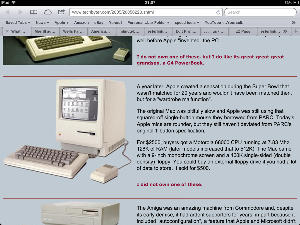 In that earlier program, I wrote "The original Mac was pitifully slow and Apple was still using that squared-off single-button mouse they borrowed from PARC. Today's Apple mice are rounder, but they still haven't deviated from PARC's original 1-button specification."
In that earlier program, I wrote "The original Mac was pitifully slow and Apple was still using that squared-off single-button mouse they borrowed from PARC. Today's Apple mice are rounder, but they still haven't deviated from PARC's original 1-button specification."
As it turns out, the 1-button mouse can be blamed entirely on Apple. Wolfgang Gunther explained: "The original PARC mouse had three buttons. I used the Alto at Xerox. In fact, when I get back to my desktop Mac, I may find and send you the Alto Manual. It was Steve Jobs who deemed that too complicated and made us work with a single button." Gunther did find that file and sent it.
Although it's been nearly 8 years since I wrote that (February 20, 2005), the correction is appropriate, if not timely.
A presentation by Microsoft Research's Butler Lampson in October 2006 addressed some of the challenges faced by those working at PARC. Gunther provided a copy of Butler's PowerPoint presentation, "The Alto and Ethernet System—Xerox PARC in the 1970s." At the time, Butler was looking back 30 years and now, 7 years on, we can look back at that presentation.
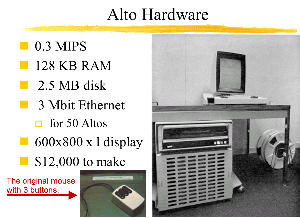 For $12,000, PARC was able to build a computer with a display that had slightly better resolution than televisions of the day, 2.5MB of disk space (about a quarter of what one current raw digital image would consume), and 128KB of RAM.
For $12,000, PARC was able to build a computer with a display that had slightly better resolution than televisions of the day, 2.5MB of disk space (about a quarter of what one current raw digital image would consume), and 128KB of RAM.
Notice particularly, though, that the Alto did have a 3-button mouse.
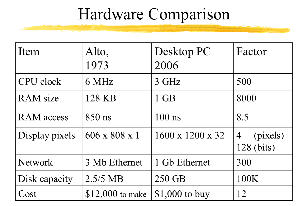 Butler Lampson's presentation compared the 1973 Alto to the 2006 desktop PC.
Butler Lampson's presentation compared the 1973 Alto to the 2006 desktop PC.
I leave it as an exercise for you to make the comparisons between those models and computers that you can buy today for $300 to $500.
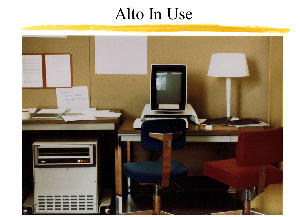 Here's an Alto in operation. That big box in the lower left is the computer and the large opening near the top of the big box is the slot where the disk platter was inserted.
Here's an Alto in operation. That big box in the lower left is the computer and the large opening near the top of the big box is the slot where the disk platter was inserted.
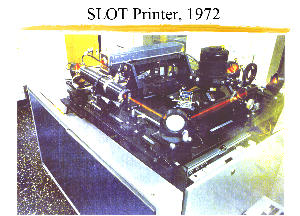 This is PARC's SLOT (Scanning Laser Output Terminal) printer. If you want to read all about the SLOT printer, here's where you'll find the story.
This is PARC's SLOT (Scanning Laser Output Terminal) printer. If you want to read all about the SLOT printer, here's where you'll find the story.
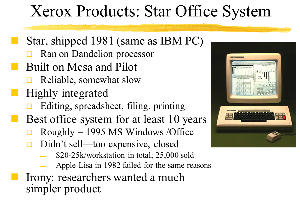 By 1981, Xerox had developed the Star Office System, a high-priced system that used a proprietary operating system. At $20,000, Xerox didn't find very many buyers.
By 1981, Xerox had developed the Star Office System, a high-priced system that used a proprietary operating system. At $20,000, Xerox didn't find very many buyers.
Apple's Lisa failed several years later for exactly the same reason.
Sometimes the right choice is simply to make something that's good enough for the time and to allow the better product to be developed when technology is ready.
Thanks to Wolfgang Gunther, both for the correction and for a fascinating resource that should serve as a reminder to us all regarding how far technology has advanced, not only in the past 40 years, but even in the past half dozen years.
On a related note, you might find CBS journalist Walter Cronkite's view of what the office of the future might look like (from 1967) both amusing (because the implementation is completely wrong) yet prescient (because the conclusions are exactly right).
Short Circuits
If You Wanted a MacBook but Waited, You Can Buy for Less
Apple has a problem: The Ipad is so hugely popular that it seems to be hurting sales of the more expensive (and more profitable) MacBooks. This has investors worried but CEO Tim Cook says there's nothing to worry about. But then came the price drop.
Apple MacBook sales dropped 21% in the last quarter of 2012 compared with the same quarter in 2011 and Apple missed Wall Street's revenue forecast for the third straight quarter.
Apple dropped the price of its base 13-inch MacBook Pro laptop by $200. That model, with the "retina" display will now sell for $1500 instead of $1700. The price of the 13-inch MacBook Air laptop with 256 gigabytes of flash memory dropped $100 to $1300.
The company maintained the same price on its 15-inch MacBook Pro but added a faster 2.4GHz quad-core processor and upgraded the top-end 15-inch notebook to a 2.7GHz quad-core processor with 16GB of memory.
Apple Has a Problem: Investors are Lining Up to Sue
Two Apple shareholders are now suing the company. A Pennsylvania investor has filed the second suit in New York's US District Court to stop the company from voting on a measure regarding preferred stock. That issue is the same as in a suit brought by hedge fund manager David Einhorn. Another issue in Brian Gralnick's suit differs from Einhorn's.
Einhorn's primary goal is to obtain a payout from Apple's large amount of readily available cash. Gralnick's suit addresses 2 proxy proposals.
"Preferred stock", according to Wikipedia, is an equity security with properties of both an equity and a debt instrument. Preferred stock ranks higher than common stock but below bonds in terms of rights to their share of the assets of the company. Preferred stock usually carries no voting rights.
Gralnick's other issue involves the rights of shareholders to have some control over the compensation of Apple's executives. He will seek to have his claim heard next week when Einhorn's case is in court. Einhorn and Greenlight Capital had previously filed suite against Apple to force Apple to distribute some of its $137 billion in available cash to investors.
We Can't Say We Haven't Been Warned (Opinion)
President Obama signed an executive order this week to ensure that the government makes available to private companies information on threats to computer security. Congress failed to pass legislation that would have provided critical threat information to businesses and the president's executive order partially resolves the problem.
Executive orders are, as the name suggests, not legislation and they can be rescinded at any time. Legislation would be better but the Washington deadlock essentially insures that if the Capitol was on fire, the only legislation that might pass would be a resolution to consider having a committee investigate the possible ways to extinguish it.
Under the executive order, companies that operate the electrical grid and financial institutions will be able to join an experimental program that will provide up-to-date reports about cyber security. Once they have the information, though, companies will be free to act on the threat analysis or ignore it. And although the Department of Homeland Security will recommend steps that companies should follow to prevent attacks, even banks and electric companies will not be required to act.
And the measure is in many ways simply security theater. Although well intentioned and necessary, the executive order is not sufficient. The executive order cannot include specific instructions for how infrastructure should be protected; that would require Congressional action. Meanwhile, the outdated hardware that's used by many systems that are critical to everyday life remain at high risk.
In the previous session of Congress, Homeland Security Secretary Janet Napolitano, FBI director Robert Mueller, and others testified in private Congressional sessions regarding the threats faced by the nation, and still nothing happened.
The attacks aren't some futuristic scenario, either. The Department of Homeland Security is already reporting electronic attacks on oil pipelines and electric power stations. I recall an incident in the 1970s at a gasoline storage facility here in Columbus. A small error in Cleveland allowed gasoline to overflow the tanks here and created a dangerous situation.
What if somebody "flipped a switch"—not accidentally but on purpose? Homeland Security says that infrastructure attacks increased by more than 50% in 2012 from 2011. Some of the attacks were successful.
What happens when coordinated attacks are launched against natural gas pipelines, gasoline distribution systems, banks, and the electric grid? We can't say that we weren't warned. One wonders when Congress will act.
